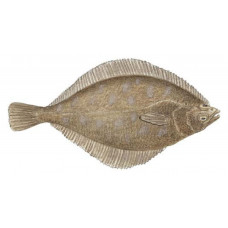Latin name
Eopsetta jordani
Other names
Sole, round-nosed sole, Jordan’s flounder, California sole, brill.
Identification
Body of petrale sole elongated, moderately slender and compressed. Eyes large, color of eyes uniformly dark or light brown, with dusky spots on dorsal and anal fins. It is white on the blind side. It has an even brown coloration and does not have a high arc in the lateral line. The dorsal fin begins on the upper contour of the head above the anterior edge of the upper eye. The head is large, the snout blunted, and the mouth large. Upper jaw goes beyond the vertical of the middle of the eye. Teeth are developed on both jaws: two rows on the upper jaw and one on the lower. The caudal peduncle is rather narrow. The scales are fine, ctenoid on the eye side of the body and cycloid on the blind side. The lateral line is straight on most of the body, forming a low, smooth curve over the pectoral fin.
Distribution
Petrale sole inhabits from the Bering Sea and Aleutian Islands in the Gulf of Alaska to the Coronado Islands in northern Baja California, Mexico.
Habitat
Sea bottom fish. Petrale sole are found on sandy and muddy bottoms in waters from 60 to 1,500 feet deep. They are most often found at depths of 180 to 400 feet from April through October, and deeper in winter.
Size
The average commercial catch is 1 to 2 pounds, but this species can reach lengths up to 28 inches and weights up to 8 pounds. 50% of males mature at age 7 at 38 cm, 50% of females mature at age 8 at 44 cm, but some specimens remain immature even at age 10. The age limit of females is 25 years, of males 19 years.
Life history and Behavior
The main spawning grounds are located in British Columbia waters at depths of up to 370 m. Spawning occurs here in late winter and early spring. The fecundity of females 42 cm long is about 400 thousand eggs, 57 cm long - up to 1 million 200 thousand eggs.
Food and feeding habits
In British Columbia waters, the main food items are euphausiids, sand lance, and herring. It also eats many bottom fish and invertebrates. The diet includes crabs, shrimp, and such fish as anchovies, hakes, small rockfish, and other flounders.
Reproduction
The eggs are pelagic with a diameter of about 1.3 mm. The incubation period at 7 °C lasts 8-9 days. The larvae hatch at 5 mm in length; the yolk sac dissolves after 10 days. Young fish of 1-2 years of age live near the bottom at depths of 18-70 m.
| Classification | |
| Phylum | Chordata |
| Class | Actinopterygii |
| Squad | Pleuronectiformes |
| Family | Pleuronectidae |
| Genus | Eopsetta |
| Species | E. jordani |
| Features | |
| Conservation status | Least Concern |
| Habitat | Bottom |
| Life span, years | No information |
| Maximum body weight, kg | 3.7 |
| Maximum length, cm | 70 |
| Sailing speed, m/s | No information |
| Threat to people | Edible |
| Way of eating | Predator |


